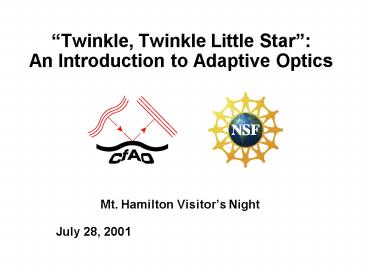Twinkle, Twinkle Little Star: An Introduction to Adaptive Optics - PowerPoint PPT Presentation
Title:
Twinkle, Twinkle Little Star: An Introduction to Adaptive Optics
Description:
Lick Observatory adaptive optics system. The Deformable Mirror ... Example: AO system at Lick Observatory's 3 m telescope. Support for main. telescope mirror ... – PowerPoint PPT presentation
Number of Views:244
Avg rating:4.0/5.0
Title: Twinkle, Twinkle Little Star: An Introduction to Adaptive Optics
1
Twinkle, Twinkle Little StarAn Introduction
to Adaptive Optics
- Mt. Hamilton Visitors Night
July 28, 2001
2
Turbulence in the atmosphere limits the
performance of astronomical telescopes
- Turbulence is the reason why stars twinkle
- More important for astronomy, turbulence
spreads out the light from a star makes it a
blob rather than a point
Even the largest ground-based astronomical
telescopes have no better resolution than an 8"
backyard telescope!
3
Images of a bright star, Arcturus
Distant stars should resemble points, if it
werent for turbulence in Earths atmosphere
4
Turbulence changes rapidly with time
Sequence of very short snapshots of a star. Movie
is much slower than "real time."
5
Measure details of blurring from guide star
near the object you want to observe
How to correct for atmospheric blurring
Light from both guide star and astronomical
object is reflected from deformable mirror
distortions are removed
Calculate (on a computer) the shape to apply to
deformable mirror to correct blurring
6
Basic idea of AO
Wavefront corrector
Aberrated wavefront
Corrected wavefront
Wavefront sensor
Wavefront control computer
7
Adaptive optics in action
Lick Observatory adaptive optics system
Star with adaptive optics
Star without adaptive optics
8
(No Transcript)
9
The Deformable Mirror
10
Deformable mirrors come in many shapes and sizes
- Today mirrors from Xinetics. From 13 to 900
actuators (degrees of freedom) 3 - 15 inches in
diameter.
Xinetics Inc.Devens, MA
- Future very small mirrors (MEMS, LCDs) very
large - mirrors (replace secondary mirror of the
telescope)
11
Adaptive optics system is usually behind main
telescope mirror
- Example AO system at Lick Observatorys 3 m
telescope
Support for main telescope mirror
Adaptive optics package under main mirror
12
What does a real adaptive optics system look
like?
Light from telescope
Wavefront sensor
Infra-red camera
Deformable mirror
13
If there is no nearby star, make your own star
using a laser
Implementation
Concept
Lick Obs.
14
Laser in 120-inch dome
15
Laser guide star adaptive optics at Lick
Observatory
Uncorrected image of a star
Laser Guide Star correction of a star Strehl
0.6
Ircal1129.fits RX J0258.31947 10/20/00
204 Ks V15 K13.32 20s S0.6 LGS
16
AO at the Keck 10 m Telescope
Adaptive optics lives here
17
Adaptive optics on 10-m Keck II Telescope
Factor of 10 increase in spatial resolution
9th magnitude star imaged in infrared light (1.6
mm)
Without AO
Without AO width 0.34 arc sec
With AO width 0.039 arc sec
18
(No Transcript)
19
(No Transcript)
20
Neptune in Infrared Light
With Keck adaptive optics
Without adaptive optics
2.3 arc sec
May 24, 1999
June 27, 1999
l 1.65 microns
21
NeptuneGround-based AO vs. Voyager Spacecraft
Infrared Keck adaptive optics, 2000
Visible Voyager 2 fly-by, 1989
22
Saturns moon Titan Shrouded by hazeas seen by
Hubble Space Telescope
Image at 0.85 microns
Hints of surface detail
Limb Brightening due to haze
23
Titan at Keck with and without adaptive optics
Titan without adaptive optics
- Titan with adaptive optics
February 26-27, 1999
Typical _at_ wavelength 1.65 mm
24
Uranus as seen by Hubble Space Telescope and Keck
AO
Hubble Space Telescope false-color image (1.1,
1.6, 1.9 mm)
Keck adaptive optics image (2.1 mm)
25
Keck AO Can See the Faintest RingsDiscovered by
Voyager
Voyager 4 groups of rings
Keck AO outer e ring plus 3 inner
groups (individual rings
unresolved)
e
d g ?
b a
4 5 6
26
A volcano erupting on Io Jupiter's largest moon
Infrared image (2 microns)
27
Io with adaptive optics sees most of the
volcanic features seen by Galileo
Same volcanoes
Same volcanoes
28
Other Uses for AO
- High-speed communications with laser beams
- Cheaper and lighter telescopes in space
- High-powered lasers for fusion power
- Vision science research
29
Why Correct the Eyes Optics?
Perfect Eye
Aberrated Eye
30
Visual Acuity Is Worse at Night When Pupils Dilate
1 mm
2 mm
3 mm
4 mm
pupil images followed by psfs for changing
pupil size
5 mm
6 mm
7 mm
31
The Rochester Adaptive Optics Ophthalmoscope
32
Adaptive optics provides a clear improvement in
retinal image quality
Wave Aberration
Point Spread Function
Retinal Image at 550nm
Retinal Image in White Light
Before adaptive optics
1 deg
After adaptive optics
YY
6.8 mm pupil
33
Adaptive optics provides highest resolution
images of living human retina
Williams, Roorda et al. (U Rochester)
With AO Resolve individual cones
Without AO
34
Looking Inside the Eye with AO
35
View of Lunar Eclipse
36
Retinal Imaging Basic Science
Scale bar 5 µm
First images of the trichromatic photoreceptor
mosaic in the human eye (Roorda and Williams,
Nature, 1999)
37
(No Transcript)
38
Primary Mirrors CELT vs. Keck
Keck
CELT
39
CELT and Stonehenge
Keck
40
CELT in PacBell Park
41
Keep your eye on Adaptive Optics!
42
How to measure turbulent distortions (one method
among many)
43
Applications and Results
44
(No Transcript)






























